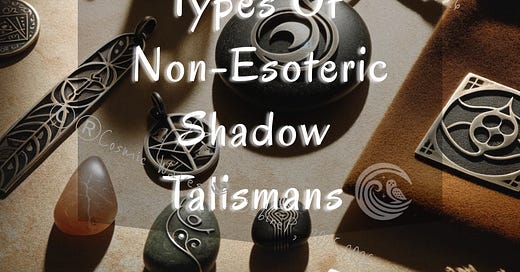Shadow Work (and Talismans) for The Non-Esoteric Practitioner (3)
As I mentioned, shadow work is for everybody - including the atheists and the religious. Here is an adaptation of esoteric rituals to match your needs. I got you!
Shadow work can still be deeply effective and transformative even for those who don’t work with deities, esotericism, or traditional magick.
Do rituals work or are they just “woo” like skeptics claim?
How about shadow talismans?
And if they work, how do they connect to our subconscious?
Ritual work is more close to who we are than we think. The core of any ritual isn’t about being psychic. It is about intentional psychological engagement, self-exploration, and emotional processing.
☆ Neuroscience proves that, no matter their intent and setup, rituals, have profound psychological and neurological effects. They speak the language of the subconscious because the brain free-associates hidden thoughts.
☆ Both neuroscience and behavioural psychology assert that the repetitive thought loops that hold us back are broken through “cognitive restructuring”, that is: repeated actions strengthen neural pathways new thought patterns, new habit loops are created in the brain. When we repeat affirmations, engage in ritual actions (physical movement and symbolic gestures), or use specific objects, we reinforce certain beliefs and emotional states.
Hence, even if someone doesn’t believe in magic or in “energy,” the act of performing a ritual creates an internal shift that influences our reality. For example:
• If you believe you are moving forward, your brain acts accordingly.
• If you expect healing or transformation, your actions will align with that belief, making it more likely.
☆ This leads us to another interesting consideration which is the placebo effect, often dismissed by some researchers not because it doesn’t work, but because they need scientific control in their research - measurable, quantifiable results.
Secondly, Western science has long separated mind from body, treating emotions and beliefs as secondary to physical health. It is only in the last decade that neuroplasticity, epigenetics, and psychoneuroimmunology (how thoughts/emotions affect immune function) started to gain traction.
Furthermore, some studies suggest that expectation and belief in treatment can produce nearly the same effect as certain medications. And if we introduce magick (not “magic” - in order to differentiate from magic which is used to create mind bending tricks), it works in the same way: belief is an undeniable force that shapes perception, behaviour and reality!
While the conscious and critical mind resists change, rituals “bypass” this by engaging the subconscious directly! The subconscious mind doesn’t process logic in a linear way like the conscious mind does. Instead, it understands images, emotions, sensations, and symbolic connections.
Thus, symbolism provides structure without even requiring any belief in mysticism. This is why, for example, dreams are full of strange but meaningful metaphors. Rituals, too, use these same symbolic patterns: the Fire element for transformation, the Water element for purification, keys for unlocking hidden truths, etc. Furthermore, they set clear expectations which create shifts in perception, behaviour, and even in biological responses.
Part of ritual work are often objects with meaning or symbols. These can be either “physical or psychological anchors” or even both.
This is how it works:
• They create a subconscious link - Through a process called “cognitive anchoring”, the brain associates such an object with a specific mental state.
• Repetition is paramount. The more we interact with these objects, the stronger this link becomes, triggering the associated meaning automatically.
Here are some examples of how anchoring works:
Writing - reinforces commitment to boundaries.
Free-writing - goes further and bypasses self-censorship, allowing deeper thoughts to surface.
Writing and discarding - Studies show writing and discarding thoughts reduces stress and rumination. E.g.: Writing down a fear and tearing it up signals to the subconscious that this fear no longer controls us. Throwing things away signal the brain to detach from past emotions.
Mental imagery techniques - are backed by psychology for managing stress and anxiety.
Wearing a specific object - associates the object with a desired mindset, reinforcing the feeling over time.
Dreamwork - The brain processes emotions during sleep, making dreams a direct link to the subconscious.
Mindfulness and behavioural changes - allow for long-term shadow integration. They bypasses logical resistance, making internal shifts easier.
Physical movement (eg. walking) - activates problem-solving in the brain.
☆ It suffice to say then that shadow talismans work in the same way. By assigning them meaning (either protection, transformation, or release), they become “psychological anchors“ that reinforce our shadow work. They link the subconscious with the material reality and help us integrate change on a deeper level.
If we engage in a shadow work ritual with intent, our subconscious makes free associations between the ritual elements and our own hidden emotions or beliefs. This is why shadow work rituals often “bring up” emotions we weren’t even expecting - because the subconscious links the ritual’s symbols to buried experiences.
Conclusively, rituals aren’t just “spiritual.” They align with how the human brain naturally processes and integrates experiences, which is why they feel powerful, even to skeptics.
Now that we have a good background in both the spiritual and the psychological meaning of talismans and rituals, let’s delve into how both the esoteric and non-esoteric talismans work and offer some suggestions how to adapt them to fit our needs.





